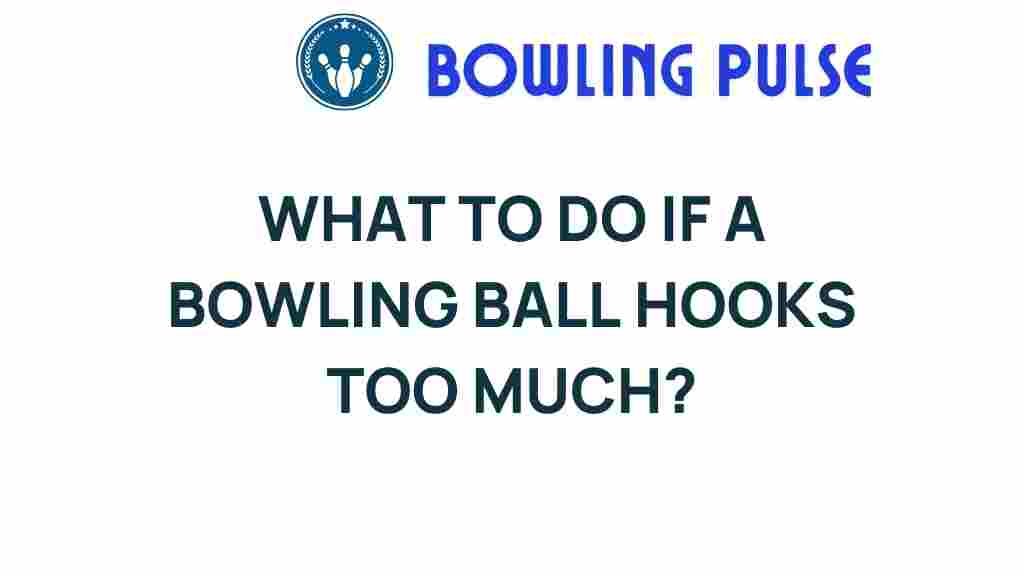Mastering the Hook: What to Do If Your Bowling Ball Hooks Too Much
When you’re on the lanes, the last thing you want is your bowling ball hooking too much. This can lead to inconsistent shots, missed spares, and ultimately, a frustrating game. Understanding how to manage your ball’s hook is crucial for any bowler looking to improve their performance. In this article, we’ll delve into effective techniques, adjustments, and strategies to help you regain control over your bowling ball’s hook.
Understanding the Hook
The hook of a bowling ball refers to its curved path as it travels down the lane. While a hook can be beneficial for striking, too much of it can lead to poor accuracy and precision. Let’s explore the factors that contribute to an excessive hook.
- Bowling Ball Design: The core and coverstock of your bowling ball significantly influence its hook potential. A ball designed for a strong hook may not be suitable for every bowler.
- Bowler’s Release: Your grip and release technique can cause the ball to hook more than intended.
- Lane Conditions: Oil patterns on the lane affect how much your ball hooks. A heavily oiled lane can create unexpected hooking.
Adjusting Your Technique
If your bowling ball hooks too much, adjustments to your technique can help. Here are some key techniques to incorporate:
1. Grip Adjustment
Your grip on the bowling ball directly affects how it behaves upon release. Consider the following:
- Finger Position: Ensure your fingers are not too deep in the holes. A shallower grip can reduce the amount of hook.
- Pressure Control: Maintain a consistent grip pressure. Too tight can lead to an excessive hook.
2. Release Technique
How you release the ball plays a critical role in its hook. Here are some tips:
- Release Timing: Focus on releasing the ball at the bottom of your swing to minimize rotation.
- Hand Position: Keep your hand behind the ball during release. This position helps in straightening the ball’s path.
3. Adjusting Your Stance
Your starting position on the approach can also affect the hook. Try these adjustments:
- Starting Position: Move your starting position to the right (for right-handers) or left (for left-handers) to change the angle of the shot.
- Footwork: Ensure your footwork is smooth. A rushed approach can lead to an inconsistent release.
Bowling Tips for Better Control
Improving your control over your bowling ball is essential for mastering the hook. Here are some additional bowling tips:
- Practice Consistently: Regular practice will help you become more attuned to how your ball reacts.
- Use the Right Equipment: Choose a bowling ball that suits your style. A ball that hooks too much can be counterproductive.
- Observe Lane Conditions: Be aware of how the lane changes throughout games and adjust your strategy accordingly.
Step-by-Step Process to Adjust Your Game
Here’s a simple step-by-step process to help you adjust your game when your bowling ball hooks too much:
- Evaluate Your Equipment: Ensure your bowling ball is appropriate for your skill level and the lane conditions.
- Assess Your Grip: Check your grip technique and make necessary adjustments.
- Analyze Your Release: Focus on your release timing and hand position for better control.
- Modify Your Approach: Experiment with your starting position and footwork.
- Record Your Progress: Keep a journal of your adjustments and their effects on your performance.
Troubleshooting Excessive Hook Issues
Even with the right techniques, you might still experience issues with excessive hooking. Here are some troubleshooting tips:
1. Ball Surface Adjustment
Consider altering the surface of your bowling ball:
- Sand the Surface: If your ball has a shiny finish, sanding it can create more friction and reduce the hook.
- Consult a Pro Shop: A professional can help you with surface adjustments tailored to your needs.
2. Change Your Ball
If adjustments don’t help, it might be time to invest in a new bowling ball:
- Low Hook Potential Balls: Look for balls specifically designed for less hook. These can provide more control.
- Consult Experts: Talking to bowling professionals can help you find the right equipment.
Strategy for Competitive Bowling
In competitive bowling, a solid strategy is essential for managing your bowling ball’s hook. Here are some strategic tips:
- Know Your Opponents: Watch how your competitors handle their shots. This can give you insight into lane conditions.
- Adjust Based on Performance: If you notice the hook is too much, be ready to adjust your strategy mid-game.
- Stay Calm and Focused: Maintain composure during the game. Stress can lead to poor decisions and technique breakdown.
Conclusion
Mastering the hook is a vital skill for any bowler. By understanding the factors that contribute to excessive hooking and employing the right techniques and strategies, you can gain better control of your bowling ball. Remember to practice consistently, be observant of lane conditions, and make adjustments as needed. With dedication and the right approach, you’ll enhance your precision and overall performance on the lanes.
For more bowling tips and resources, consider exploring this comprehensive guide on bowling techniques that can further help refine your skills. Additionally, if you want to learn about the best bowling balls available, check out this external resource for expert reviews.
This article is in the category Techniques and created by BowlingPulse Team
